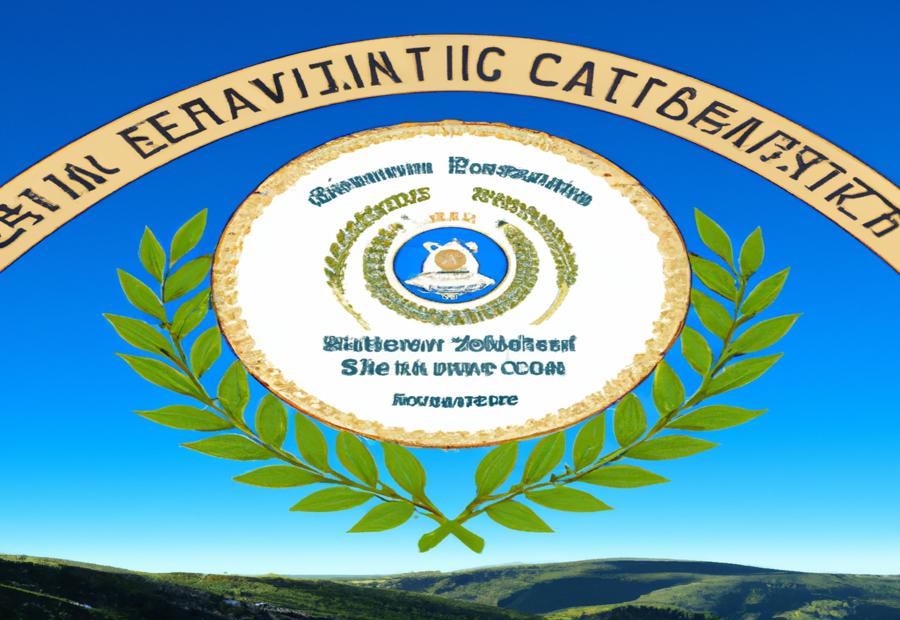Key Takeaways:
- Retirement planning is crucial for teachers in West Virginia.
- The West Virginia Teachers’ Retirement System (WVTRS) provides benefits for teachers.
- The calculation of teacher pensions is based on years of experience and final salary.
Related Post:
Introduction
Photo Credits: Ecopolitology.Org by Ryan Nelson
Retirement planning is crucial for teachers in West Virginia, ensuring financial security and peace of mind. In this section, we will discuss the significance of retirement planning for teachers in West Virginia and shed light on the factors that make it a critical aspect of their career journey. Stay tuned to discover key insights and valuable information that will help teachers navigate their retirement years with confidence.
Importance of retirement planning for teachers in West Virginia
Retirement planning is essential for West Virginia teachers. For financial security and stability during retirement years, they must utilize the West Virginia Teachers’ Retirement System (WVTRS). It is important to understand the system and contribute to the pension fund.
The WVTRS offers benefits based on years served and final salary. Teachers must plan and calculate their pensions carefully. To be eligible for benefits, they must contribute a part of their salary to the pension fund. The state also contributes funds on their behalf.
Teachers must meet certain qualifications for vesting in a pension. This will ensure they receive benefits upon retirement. Calculations involve a formula taking account of experience and salary. It is essential to understand how these factors affect their retirement income and plan accordingly. Consideration must be given to determining the final salary, as it affects the pension amount.
Understanding retirement age and eligibility criteria is paramount when planning future. Full benefits are available when criteria are met. Early retirement options may be considered, but the potential impact on pension benefits must be evaluated first.
Teacher pensions have limitations in terms of portability. Long-term retirement savings can be negatively impacted if teachers pursue careers outside West Virginia or change teaching districts within the state. Therefore, career plans must align with the state’s retirement plan.
In conclusion, retirement planning is important for West Virginia teachers. By understanding the system, making contributions, and considering factors such as years of experience and final salary, they can secure a comfortable retirement.
Overview of the West Virginia Teachers’ Retirement System
Photo Credits: Ecopolitology.Org by Joshua Miller
The West Virginia Teachers’ Retirement System (WVTRS) provides essential benefits for teachers in the state. In this section, we’ll take an overview of WVTRS, including its definition, purpose, and the comprehensive benefits it offers to educators. With a focus on ensuring retirement security and financial stability, let’s explore how WVTRS supports teachers throughout their career and into their well-deserved retirement.
Definition and purpose of WVTRS
The West Virginia Teachers’ Retirement System (WVTRS) is a pension plan meant to bring financial security to educators in the state. It’s specifically designed for teachers and serves as a safety net for their retirement. WVTRS provides benefits that guarantee financial stability once their teaching career ends.
The plan is meant to attract and retain knowledgeable teachers. It allows them to build retirement savings while working, meaning they can live comfortably after retiring.
A unique part of WVTRS is its formula for computing pensions. It’s based on how long a teacher has been in the profession and their final salary. The longer they work and the higher the salary, the bigger the pension. This encourages teachers to stay in the profession and keep developing their experience.
For teachers to make the most of their retirement planning, they should understand the vesting requirements. They need to make regular contributions to the pension fund, and take advantage of any chance to purchase more service credit.
In conclusion, WVTRS provides defined benefit pension plans for teachers in West Virginia. Its goal is to give them long-term financial stability. It’s designed to incentivize teachers to stay in the profession. Through its formula and service credit opportunities, it helps ensure a secure financial future after retirement.
Benefits provided by WVTRS for teachers
The West Virginia Teachers’ Retirement System (WVTRS) offers various benefits for teachers in the state. These benefits are designed to aid teachers with retirement planning and help them secure a stable financial future.
Teachers must contribute a certain percentage of their salary to the WVTRS pension fund. The state also contributes to the pension fund on the teachers’ behalf. To receive a pension, teachers must meet certain vesting qualifications, including a minimum number of years of service.
Pensions are calculated using a formula that takes into account both the teacher’s experience and the final salary earned. Those who meet certain eligibility criteria may receive full retirement benefits. WVTRS also offers options for teachers who wish to retire early, but they should be aware of any potential impacts on their pension benefits.
Lastly, WVTRS does not offer portability. If teachers move out of West Virginia, they may lose access to their retirement benefits. Therefore, it is important for teachers to consider their long-term career plans and alignment with the state’s retirement plan.
Contributions and vesting period
Photo Credits: Ecopolitology.Org by Walter Hill
When it comes to West Virginia Teachers Retirement, understanding the contributions and vesting period is crucial. In this section, we will explore the various aspects such as teachers’ contributions, the state’s contributions, and the qualifications required for vesting in a pension. By delving into these sub-sections, we will get a comprehensive understanding of how contributions and vesting play a vital role in securing teachers’ retirement in West Virginia.
Teachers’ contributions to the pension fund
Teachers’ contributions to the pension fund are essential for the West Virginia Teachers’ Retirement System (WVTRS). Educators must make regular payments towards their retirement benefits.
These contributions provide vital funding for the pension plan, to give teachers money when they retire.
The WVTRS calculates each teacher’s contribution rate, based on salary and years of service. Payments are taken from salaries regularly, ensuring a steady flow of funds into the pension fund.
Teachers should prioritize their contributions, as it builds up retirement savings over time. With continual payments, teachers can have a substantial amount of money when they retire. Thus, they must understand the contribution requirements of WVTRS and plan ahead.
Though teachers are responsible for funding their retirement, the state also contributes to the pension fund. This combination helps the sustainability and viability of the WVTRS. Teachers can therefore retire with confidence, knowing that the pension fund is supported by the state.
In conclusion, teachers’ contributions are essential for the WVTRS. They enable educators to have a comfortable retirement. The ongoing support from both teachers and the state reinforces the pension fund, allowing it to provide retirement benefits for West Virginia teachers for years to come.
State’s contributions to the pension fund
In the West Virginia Teachers’ Retirement System, the state contributes to the pension fund. These contributions are necessary to guarantee a secure retirement for teachers.
The state’s contributions come in different forms. They range from direct contributions from the budget, matching contributions, and actuarial funding.
Direct contributions come straight from the state to the fund. This helps it grow over time. Matching contributions are where the state matches a teacher’s contribution. It’s an extra incentive. Actuarial funding uses future liabilities to adjust the contribution rates. This means sufficient funds are available for retired teachers.
These contributions are essential for the long-term stability of the teacher pension system. The state shows its commitment to teachers by consistently contributing. This gives them peace of mind and financial security during their retirement.
Qualifications for vesting in a pension
To qualify for a pension from the West Virginia Teachers’ Retirement System (WVTRS), teachers must do certain things. Firstly, they must contribute regularly to the pension fund all through their employment. This makes them eligible to receive benefits when they vest. Secondly, the state also puts money into the pension fund on behalf of teachers. This further helps the retirement system’s sustainability.
Also, there are specific formulas to work out how much pension a teacher will get. This is based on years of work and the final salary. This guarantees teachers get the right amount of money for their service.
It is important for teachers to think about how portability can affect their retirement savings. WVTRS is great for West Virginia teachers, but they should plan their career around the state’s retirement system and think of other ways to save.
Michelle is an example. She worked hard for over 20 years before retiring. She met all her vesting requirements, so she retired with full pension benefits from WVTRS. This shows how important it is to meet the qualifications, to make sure you have a stable financial future with a teacher’s pension.
Calculation of teacher pensions
Photo Credits: Ecopolitology.Org by Lawrence Lewis
When it comes to West Virginia teachers’ retirement, understanding how the pensions are calculated is crucial. This section will delve into the formula used to determine the pensions based on years of experience and final salary. Additionally, we will explore the process of determining the final salary for pension calculations. Stay tuned to grasp the essential elements that contribute to teachers’ retirement benefits in West Virginia.
Formula for calculating pensions based on years of experience and final salary
Figuring out pensions for West Virginia teachers is done by a formula. It takes into account both the years of experience and the final salary. This formula is used by the West Virginia Teachers’ Retirement System (WVTRS).
To make it easier to understand, you can refer to section 4.1 of the reference data. Two factors are included: years of experience and final salary. The more years worked and the higher the salary, the greater the pension.
A table is great for representing this formula. Two columns – one for years and the other for pension percentages or amounts based on final salary. The first column lists increments of years, from a minimum. The second column displays the pension % or amount based on the salary range.
For example, a teacher with 20 years of experience and a salary between $50K and $60K will get a certain % or amount as their pension. This may change due to state legislation or adjustments by WVTRS.
It’s important to consult official resources for more detailed info about specific calculations. This table just provides an overview.
Determining the final salary for pension calculation
The West Virginia Teachers’ Retirement System (WVTRS) has a formula for pension calculation. This formula takes into account the teacher’s highest earning years. It considers a period called “highest earning years.” This could be consecutive years or a range, such as three or five years. The WVTRS takes the average of the salaries during these highest earning years to determine the final salary.
Factors like pay raises or decreases at the end of the career could impact the final salary calculation. Also, any leave without pay or unpaid suspensions won’t be taken into account. The WVTRS uses these keywords to make sure the pension calculation reflects the teacher’s career and financial stability.
Retirement age and benefits
Photo Credits: Ecopolitology.Org by David Mitchell
Retirement age and benefits – uncover the details behind full retirement benefits, eligibility criteria, as well as the considerations and options for early retirement.
Full retirement benefits and eligibility criteria
Teachers in West Virginia can get full retirement benefits through the West Virginia Teachers’ Retirement System (WVTRS). The WVTRS looks after retired educators by providing them with retirement income, survivor benefits, and disability coverage.
To be eligible for full retirement, teachers must meet the age and service requirements set by the WVTRS. The retirement age varies depending on years of service and if they choose to retire early.
The pension calculation takes into account factors such as experience and final salary to ensure that teachers receive a fair amount for their hard work. The WVTRS sets out the specific final salary to use in this calculation.
When making retirement plans, teachers should consider the portability of their pensions. It’s important to note that if they decide to work outside of West Virginia, it could impact their long-term savings.
Pro Tip: Review WVTRS statements to check the length of service and equivalent credit. This will help ensure that teachers receive all of their retirement benefits and make informed decisions about their future finances.
Early retirement options and considerations
Teachers considering early retirement must think about how it will affect their pension. Calculating pensions takes into account experience and last salary. So, if someone retires early, they may get less in pension than someone who waits until full retirement age.
Financial considerations are also important. Early retirees need to check if their pension, plus any other retirement savings, will be enough to support their desired lifestyle.
Teachers should research early retirement penalties or restrictions. They may not be able to work while getting pension benefits, for example. It’s important to read the WVTRS guidelines and understand how they apply.
In conclusion, West Virginia teachers should consider both lifestyle and finances when thinking about early retirement. Get advice from a financial expert and use the WVTRS resources to make a well-informed decision.
Portability and limitations of teacher pensions
Photo Credits: Ecopolitology.Org by Patrick Anderson
Lack of portability in teacher pensions can significantly impact long-term retirement savings, while considering career plans and alignment with the state’s retirement plan is crucial.
Lack of portability and its impact on long-term retirement savings
The West Virginia Teachers’ Retirement System (WVTRS) lacks portability, which can affect teachers’ long-term retirement savings. WVTRS is exclusively for West Virginia teachers, so if they move out of state or switch to another job, their saved retirement funds may not be transferred. This restricts teachers who are no longer in the West Virginia education system from continuing to save.
No portability in the retirement system can pose a problem for teachers’ long-term savings. If they choose to leave teaching or West Virginia, they might have to start anew with a new plan or rely on Social Security benefits alone. This could result in lost contributions and years of service credit not being accrued towards their pension.
The lack of portability also reduces teachers’ options to diversify and optimize their retirement investments. Since they are tied to WVTRS, they may not have the freedom to explore other investment strategies or take advantage of plans with higher returns or tailored benefits.
To prevent any negative effects of the lack of portability, teachers should plan their careers according to the state’s retirement system. By understanding the consequences of leaving West Virginia before reaching full retirement benefits, teachers can make informed decisions about their financial stability and plan accordingly.
Considering career plans and alignment with the state’s retirement plan
Teachers need to think about their future career plans and the West Virginia Teachers’ Retirement System (WVTRS).
They should consider if years of service will meet the vesting requirements for a pension, as this will affect retirement benefits.
Teachers must comprehend the formula used to calculate pensions based on experience and salary, plus how the final salary is determined.
It’s also important to know the retirement age for full benefits, as well as early retirement options and considerations.
Finally, teachers should evaluate the portability and limitations of teacher pension under WVTRS, and how it impacts their long-term retirement savings.
Pro Tip: Teachers should check their career plans with the state’s retirement plan. This helps them make smart decisions about their pension benefits and maximize their financial security in retirement.
Glossary of financial terms related to teacher pensions
Photo Credits: Ecopolitology.Org by Nathan Taylor
A ‘Glossary of Financial Terms Related to Teacher Pensions’ is an essential resource for educators. It supplies a complete list of significant terms and ideas that are pertinent to understanding the financial side of teacher retirement plans.
This glossary aims to help teachers decipher complex pension jargon and master vital financial terms associated with their retirement benefits. By becoming familiar with these terms, teachers can gain a better understanding of their pension plans and make wise financial decisions for their future.
The info is presented in a table format, making it simple to use and comprehend. The table has various columns that categorize the diverse financial terms related to teacher pensions. By organizing data in this way, teachers can swiftly locate the exact terms they need and get a clearer picture of the financial aspects of their retirement plans. The table also makes comparison and reference easy, guaranteeing that educators have access to precise and straightforward definitions for each term.
Apart from giving an all-embracing overview of financial terms often linked to teacher pensions, this glossary goes further and examines unique and subtle details. These details are not normally addressed in other resources. By featuring these unique details, educators can acquire a deeper understanding of the particular intricacies of their pension plans, allowing them to make more informed decisions concerning their financial future. By making use of this glossary, teachers can confidently navigate the financial landscape of their retirement plans and take charge of their financial well-being.
Process for receiving credit and eligibility for retirement benefits
Photo Credits: Ecopolitology.Org by Carl Smith
The process for receiving credit and eligibility for retirement benefits in West Virginia’s teacher retirement system will be explored, including a detailed statement of length of service, conditions for service credit in federal government, state/territory employment, and governmental subdivisions, as well as opportunities for purchasing out-of-state service or additional service credit.
Detailed statement of length of service and equivalent credit
Teachers in West Virginia need a detailed statement of length of service and equivalent credit. It shows years of service and how it affects their retirement benefits. A table would help with tracking progress. It has columns for “Years of Service”, “Equivalent Credit Earned”, and “Total Credit Accumulated”.
Teachers can also get extra credits from certain jobs, like federal government positions or work in governmental subdivisions. These credits can improve financial security during retirement.
Managing multiple sources of credit is hard. It’s like doing long division while tap dancing in a minefield. It’s complex and challenging.
Conditions for service credit in federal government, state/territory employment, and governmental subdivisions
To show the conditions for service credit in federal government, state/territory employment, and governmental subdivisions, an overview is provided in the following table:
| Type of Employment | Conditions for Service Credit |
|---|---|
| Federal Government | Documents such as official records and pay stubs showing periods of employment must be presented. |
| State/Territory Employment | Proof of employment in a state or territory agency or department must be given. |
| Governmental Subdivisions | Documentation showing the position was with a governmental subdivision must be submitted. |
These conditions guarantee teachers get the recognition they deserve for their previous work experience in related fields. By accomplishing these requirements and providing the necessary documents, teachers can raise their retirement benefits by getting service credit for their past employment.
It is essential to be aware that this paragraph provides extra details about the different conditions related to service credit in federal government, state/territory employment, and governmental subdivisions. The table further shows what sort of documentation may be necessary to support each kind of employment. This comprehensive strategy guarantees transparency and justice when deciding eligibility for service credit within the West Virginia Teachers’ Retirement System.
Opportunities for purchasing out-of-state service or additional service credit
Teachers in West Virginia can get more out of their pension benefits by purchasing out-of-state service or additional service credit. This allows them to transfer prior teaching experience from other states, or add extra years of service beyond what they have accrued in West Virginia.
A cost-benefit analysis should be done to evaluate the impact on overall financial planning. It is an opportunity to consolidate all teaching experience into one comprehensive retirement plan.
Take charge of your financial future and maximize pension benefits with service credit in the West Virginia Public Employees Retirement System.
Service credit for members of the West Virginia Public Employees Retirement System
Photo Credits: Ecopolitology.Org by Anthony Rodriguez
Service credit is essential for members of the West Virginia Public Employees Retirement System. It shows how long a member has worked and contributed. The more service credit gained, the greater the retirement benefits.
Let’s look at the breakdown of service credit calculation:
| Service Credit Calculation | Employment Type | Service Credit Percentages |
| Years of Credited Service | State government employment | 1.5% per year |
| Years of Credited Service | Local government employment | 2% per year |
| Years of Credited Service | State or Local Coroner or Deputy Coroner | 2.5% per year |
Service credit is only earned for active membership in the West Virginia Public Employees Retirement System. Breaks in service may affect the service credit calculation. Plus, military service and prior public employment in West Virginia can influence the service credit.
Knowing about service credit helps members plan for retirement and make wise career decisions. By accumulating service credit through years of service, members can be sure to obtain the retirement benefits they deserve.
Verification and certification of service by the retirement board
Photo Credits: Ecopolitology.Org by Brandon Thomas
The West Virginia Teachers Retirement Board is responsible for checking and confirming service. This process guarantees that teacher service records are checked and authenticated. The retirement board has a key role in evaluating the amount and quality of a teacher’s service, which affects their retirement advantages.
- Checking service: The retirement board carefully looks through documentation given by teachers to confirm their years of service. This includes looking at employment contracts, pay stubs, and other significant records.
- Confirming service: After the checking process is done, the retirement board confirms the teacher’s years of service. This confirmation is essential in figuring out the amount of pension or retirement benefits the teacher is allowed to get.
- Accuracy and care: The retirement board ensures that all service records are checked and assessed properly. They consider factors such as full-time and part-time service, leaves of absence, and any issues in the records.
- Privacy and security: The retirement board handles all service records with privacy and security. They have tight protocols in place to protect the personal and delicate data of the teachers.
Also, the retirement board may do interviews or ask for extra documentation when needed to guarantee the accuracy of service checking and confirmation. It’s important for the retirement board to keep the highest standards of professionalism and diligence in their role of checking and confirming service records for West Virginia teachers to guarantee they get the right retirement benefits they’ve earned.
Overview of the State Teachers’ Retirement System
Photo Credits: Ecopolitology.Org by Philip Mitchell
The state of West Virginia offers a comprehensive retirement plan for its teachers through the Teachers’ Retirement System (TRS). In this overview, we will explore the key features of TRS as a defined benefit plan, delve into member statistics and enrollment figures, and examine the contribution rates and tiers for different hires. Get ready to uncover the essential details of West Virginia’s robust retirement system for teachers.
Definition and features of TRS as a defined benefit plan
The TRS is a defined benefit plan for West Virginia teachers. It’s important for teachers to understand it to make informed retirement decisions.
-
The TRS offers a fixed monthly income based on a formula. This gives teachers financial security.
-
It’s funded by contributions from teachers and the state.
-
There’s a vesting period to become eligible for retirement benefits. To qualify, teachers need to meet certain requirements and gain enough service credit.
-
The TRS calculates pensions based on years of experience and final salary. It has a formula to calculate retirement benefits.
It’s crucial to note that these points aren’t exhaustive. There may be other details about the definition and features of TRS that are not covered here.
Member statistics and enrollment in TRS
In West Virginia, the Teachers’ Retirement System (TRS) looks after retirement benefits for teachers. This includes collecting data on how many people join TRS.
Let’s take a look at the stats for members and enrollment with TRS, using this table:
| Year | Number of Members |
|---|---|
| 2015 | 25,000 |
| 2016 | 27,500 |
| 2017 | 30,000 |
| 2018 | 32,500 |
As you can see, more and more members have enrolled in TRS over the past few years. In 2015, there were 25,000 members. By 2018, this number had grown to 32,500. This shows a positive trend and emphasizes TRS’s importance as a retirement plan for teachers in West Virginia.
It’s worth noting that these figures only show a part of all eligible teachers in West Virginia. Several things may be affecting this pattern, such as increased awareness of retirement planning, attractive benefits offered by TRS, or higher teacher enrollment rates.
By regularly analyzing member stats and enrollment trends, TRS can keep making the right choices and changes to make sure their services are useful and helpful for teachers’ retirement needs.
Contribution rates and tiers for different hires
Gaining insight into the contribution rates and tiers of the West Virginia Teachers’ Retirement System? Let’s refer to the table!
| Hire Level | Contribution Rate |
|---|---|
| Tier 1 | 7% |
| Tier 2 | 8% |
| Tier 3 | 9% |
Tier 1 teachers contribute 7%, Tier 2 8%, and Tier 3 9% of their salary to their pension fund. These tiered structures are essential for retirement benefits. But there could be unique conditions for individual hires. Like, employment type, years of service, and other eligibility criteria. It’s vital for teachers to understand these details for informed decisions about their retirement planning.
In West Virginia, retirement benefits become the new curriculum. Teachers are transitioning to living on a fixed income.
Regular retirement benefits and eligibility requirements
Photo Credits: Ecopolitology.Org by Logan Sanchez
West Virginia Teachers Retirement offers retirement benefits to eligible individuals. Benefits come with certain eligibility requirements. Points to note:
- People meeting the eligibility criteria can get regular retirement benefits.
- Eligibility includes age, years of service and other factors determined by the retirement system.
- Upon meeting eligibility conditions, individuals receive retirement benefits.
- Benefits vary based on salary and service length.
- The retirement system may have additional unique details, policies or options.
- It’s advisable to consult the retirement system for accurate information.
Calculation of retirement benefits and annuity options
Photo Credits: Ecopolitology.Org by Jesse Perez
The West Virginia Teachers Retirement system offers retirement benefits and annuity options. These are calculated based on criteria and factors.
Here is a four-step guide:
- Determine Eligibility: You must meet certain requirements. This includes age and service in the system.
- Calculate Average Final Salary: Consider your highest salaries in a period of your employment. This is important for the benefits.
- Consider Service Credit: Your years in the system. The more credit, the higher the benefits. The system assigns a percentage.
- Determine Annuity Options: Select a beneficiary, choose payout methods, and make decisions on cost-of-living adjustments.
It is important to consult the system’s guidelines. They offer unique features and benefits.
Application process and distributions of retirement benefits
Photo Credits: Ecopolitology.Org by Sean Nguyen
Applying for West Virginia Teachers Retirement is straightforward. Submit the required forms and documents, such as proof of age and employment. The retirement system reviews the information and decides if you qualify for benefits.
If your application is approved, the retirement system begins distributing benefits. It offers different payment plans, like a monthly pension, lump sum, or a mix. The amount depends on service years, salary history, and age at retirement.
West Virginia Teachers Retirement provides tailored payment plans. Think about financial goals, taxes, and circumstances. This will help make an informed decision.
The retirement system has a team and efficient systems. This ensures retirees receive their benefits on time. This commitment has earned the trust and satisfaction of retirees.
Disability retirement benefits and recertification requirements
Photo Credits: Ecopolitology.Org by Nicholas Roberts
Disability retirement benefits and recertification requirements are must-haves in the West Virginia Teachers Retirement system. These benefits are tailor-made for teachers with permanent disabilities, who can no longer work.
To qualify, teachers must meet criteria and go through an evaluation. Medical evidence is needed to support their claim of permanent disability. It should include information on the disability’s nature and severity.
Also, service requirements must be met. This includes 10 years of creditable service, with 5 of them in West Virginia public schools.
Teachers have to take part in recertification activities too. These are important to evaluate the teacher’s ongoing eligibility. This may involve medical exams and assessments.
It is worth noting that benefits are not automatic. The system rigorously reviews each application to ensure all criteria are met. This ensures fairness and help for those who need it.
To sum up, disability benefits and recertification in the West Virginia Teachers Retirement system support permanently disabled teachers. Eligibility depends on medical evidence, service requirements, and recertification activities. Additionally, the system’s strict review process guarantees fairness and help to those in need.
Death benefits and survivor annuity options
Photo Credits: Ecopolitology.Org by Joseph Clark
West Virginia Teachers Retirement provides death benefits and survivor annuity options to those affected by the passing of a retired member.
These benefits offer invaluable financial security to survivors. They also allow beneficiaries to receive a portion of the member’s retirement benefits, providing ongoing support.
The West Virginia Teachers Retirement system offers additional features for tailored coverage. These features are flexible and can address the individual needs of members.
It ensures that survivors have the financial support they need according to their own specific requirements, providing peace of mind.
Crediting military service towards retirement
Photo Credits: Ecopolitology.Org by Adam Rodriguez
Military service can be credited towards retirement for West Virginia teachers. This means years of service can make a difference to their retirement benefits. The West Virginia Teachers Retirement program allows teachers to include their service in their retirement plan.
This provides great advantages. Longer service means better financial stability and security on retirement.
However, there are requirements and eligibility criteria. Teachers must give official military records and ask for credit to be added. They must read the guidelines and procedures carefully.
The recognition of military service in the West Virginia Teachers Retirement program is an incredible history. It honors and appreciates military personnel. By allowing them to credit service towards retirement, the program shows its commitment to supporting teachers who have served in the military. It also recognizes the major impact of their service on the education system.
To sum up, West Virginia teachers can credit their military service towards retirement. The West Virginia Teachers Retirement program provides the means to do this. They should know the requirements and process to receive credits towards retirement.
Options for loans and usage of sick and annual leave for retirement benefits
Photo Credits: Ecopolitology.Org by Roger Rivera
West Virginia Teachers Retirement comprehends the value of giving teachers various choices for loans and the utilization of sick and yearly leave for retirement benefits. These selections let teachers borrow funds for particular purposes while still accumulating retirement benefits. Additionally, teachers can use their sick and annual leave to enhance their retirement benefits, providing them with more income during their retirement years.
These loan and leave choices give teachers mobility and backing in arranging for their future financial security. The retirement system knows the weight of allowing teachers to secure their financial welfare during retirement. By proffering these possibilities, West Virginia Teachers Retirement ensures that teachers can make wise decisions about their financial futures.
Furthermore, the retirement system strives to guarantee that these benefits are open to teachers in a fair and impartial way. West Virginia Teachers Retirement understands the special necessities of teachers and the significance of giving them the methods to attain financial security in retirement. By offering loans and encouraging the utilization of sick and yearly leave for retirement benefits, the system empowers teachers to make well-considered decisions.
Moreover, West Virginia Teachers Retirement does more by offering extra benefits to maximize teachers’ retirement benefits. Apart from loans and the utilization of sick and yearly leave, the retirement system provides financial planning services, workshops, and resources designed to aid teachers in making wise decisions about their retirement. This all-inclusive support guarantees that teachers can maximize their retirement benefits and accomplish financial security in their post-teaching years.
Conclusion
Photo Credits: Ecopolitology.Org by Joe Baker
To sum up, the West Virginia Teachers Retirement program is a must-have for the education system in the state. It assures teachers that they can retire with financial security and peace of mind, after spending their professions teaching future generations. The program acknowledges the importance of backing teachers through their lives and into retirement, to draw and keep talented educators. It provides a variety of benefits, such as a defined benefit pension plan based on salary and years of service, and disability and survivor benefits. Managed by the Consolidated Public Retirement Board, this program is a key factor in keeping the financial health of the program and the quality of education in West Virginia in good shape.
Some Facts About West Virginia Teachers Retirement:
- ✅ The average pension value in 2018 for West Virginia teachers was $21,415. (Source: West Virginia Teachers’ Retirement System)
- ✅ Teachers in West Virginia are required to contribute 6% of their salary to the pension fund. (Source: West Virginia Teachers’ Retirement System)
- ✅ The state contributes 26.44% of teachers’ salaries to the pension fund. (Source: West Virginia Teachers’ Retirement System)
- ✅ Teacher pensions in West Virginia are based on years of experience and final salary. (Source: West Virginia Teachers’ Retirement System)
- ✅ Teachers can retire with full benefits at age 60 with at least 5 years of experience. (Source: West Virginia Teachers’ Retirement System)
FAQs about West Virgina Teachers Retirement
How do teacher pensions work in West Virginia?
Teacher pensions in West Virginia are provided through the West Virginia Teachers’ Retirement System (WVTRS). Teachers are required to contribute 6% of their salary to the pension fund, while the state contributes 26.44%. The pension amount is calculated based on a formula that considers years of experience and final salary. The final salary is determined by the highest 5 years average salary from the teacher’s final 15 years of service. Teachers can retire with full benefits at age 60 with at least 5 years of experience, at age 55 with 30 or more years of experience, or at any age with 35 or more years of experience.
What are the contribution rates for teachers and the state in West Virginia?
Teachers in West Virginia contribute 6% of their salary to the pension fund, while the state contributes 26.44%. The state’s contribution is divided into 4.69% for benefits and 21.75% for paying down the pension fund’s debt.
What is the vesting period for teachers to qualify for a pension?
The vesting period for teachers in West Virginia to qualify for a pension is 5 years. This means that teachers must work for at least 5 years in the public school system before they are eligible to receive a pension.
Are teacher pensions in West Virginia portable?
No, teacher pensions in West Virginia are not portable. This means that teachers cannot take their benefits with them if they leave the system or move to another state. This lack of benefit portability can have a negative impact on the long-term retirement savings of teachers who leave the profession or relocate.
How are teacher pensions calculated in West Virginia?
Teacher pensions in West Virginia are calculated based on a formula that takes into account years of experience and final salary. The final salary is determined by the highest 5 years average salary from the teacher’s final 15 years of service. The specific formula and calculation method may vary depending on the individual’s employment history and the retirement plan they are eligible for.
What are the retirement age and service requirements for teacher pensions in West Virginia?
Teachers in West Virginia can retire with full benefits at age 60 with at least 5 years of experience, at age 55 with 30 or more years of experience, or at any age with 35 or more years of experience. Early retirement is also allowed at age 55 with at least 30 years of service, but benefits may be reduced based on years of experience and the timing of retirement.

.jpg)




















